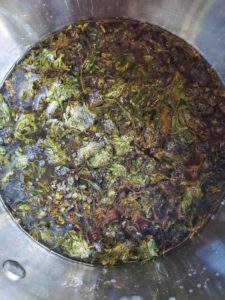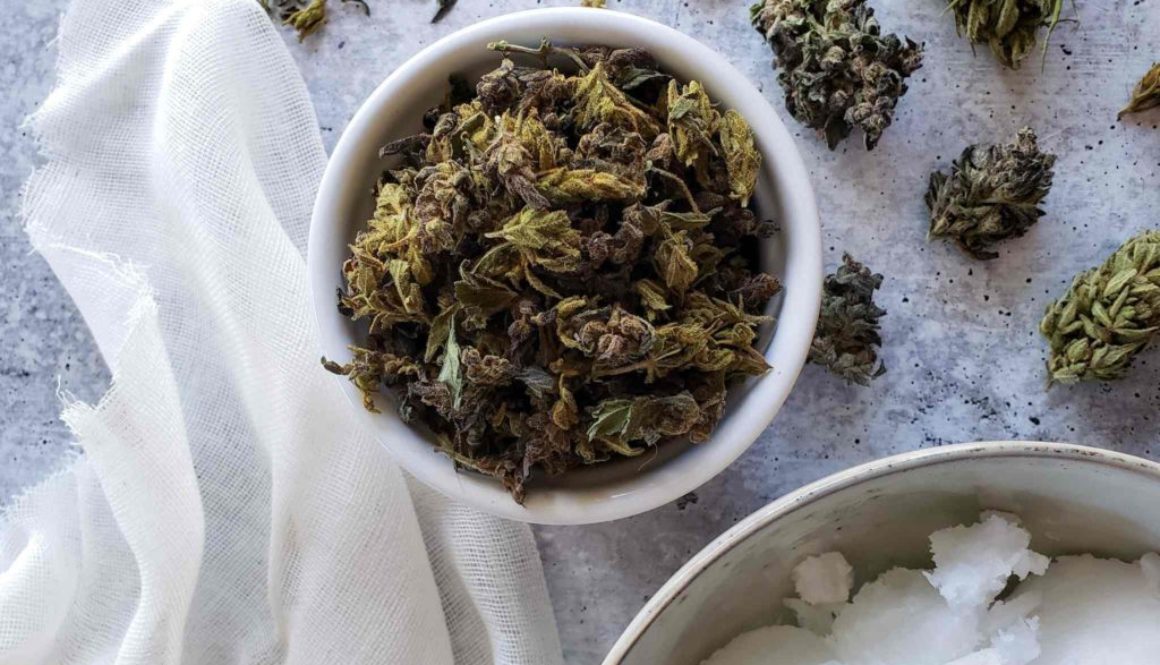How to Make CBD Oil at Home
By DeannaCat
Are you interested in making your own cannabis-infused oil? I don’t blame you! Making homemade cannabis oil is a great way to create a highly healing, concentrated, and versatile cannabis product. It is ready to use in edible recipes, topical salves, or even enjoy straight on its own. Especially if you use organic homegrown cannabis like we do, this is an excellent way to use up any extra or “fluffy” stuff too. It also happens to be very easy to make cannabis oil at home!
Follow along with these step-by-step instructions to learn how to make homemade cannabis oil. We’ll also briefly discuss the science behind cannabis oil, and what types of cannabis to use to make oil. Finally, we’ll go over various ways to use homemade cannabis oil, including some notes about caution and dosing with edibles.
What is Cannabis-Infused Oil
Cannabis oil is made by lightly heating (and thus infusing) cannabis in a “carrier oil”. Cannabinoids like CBD and THC, the most active components in cannabis, are both hydrophobic. That means they don’t like water, and are actually repelled by water molecules. On the flip side, CBD and THC are both fat-soluble. They like to bind with fatty acid molecules – such as those found in oil. When cannabis is steeped in oil, the THC and CBD molecules leave the buds or plant material and become one with the oil instead.
A wide variety of oils can be used to make cannabis oil. However, coconut oil and olive oil are the most popular and common. Coconut oil and olive oil are both pleasant-tasting and very nourishing for skin, making them versatile options for either medicated edibles or topical applications. Plus, they both have strong natural antifungal and antimicrobial properties. This helps prevent mold and extends the shelf life of your cannabis oil. Coconut oil is higher in saturated fat, which may bind fat-loving cannabinoids even more readily than olive oil.

Cannabinoids + fat (coconut oil) = BFFs
Hemp Oil, CBD Oil, THC, or…Your choice! You can make cannabis-infused oil with hemp or marijuana, depending on what is legal and available in your area. Or, what you’re desired end-results are. Hemp oil will only contain CBD (or a very minuscule amount of THC), while marijuana-infused oil will likely contain both THC and CBD. The ratio and concentration of THC and/or CBD depends on the strain of marijuana and particular plant it came from.
Generally speaking, THC is psychoactive and CBD is not. But THC does a lot more than change your state of mind! Studies show that THC has even stronger pain and stress-relieving properties than CBD, which is known to help with insomnia, seizures and inflammation. While they each have notable and distinct stand-alone benefits, an oil or salve containing both CBD and THC has the highest potential for a wide array of health benefits (albeit illegal in some places). Known as the “entourage effect”, the synergistic combination of both THC and CBD through whole-plant cannabis consumption and extracts is more powerful than either one on its own.
I personally like to use strains that are high in both THC and CBD to make oil and salves. To learn more about the differences between strains, CBD and THC, see this article: “Sativa, Indica & Autoflowers, the Differences Explained”.

CBD versus THS benefits, via CBD Farmhouse
Why Make Cannabis Oil
Cannabis oil is the foundation ingredient for ultra-healing homemade topical lotions, ointments, and salves – my favorite way to use it! Both THC and CBD have excellent anti-inflammatory, antimicrobial, and antioxidant properties. Studies have shown that cannabinoids have the ability to reduce acne, fine lines and wrinkles, soothe redness and irritation, and balance natural skin oils. Also, cannabinoids (THC especially) are analgesic – meaning they reduce pain. I regularly use our homemade cannabis salve on my knees, ankles, and other aching or inflamed joints and muscles.
Furthermore, making cannabis oil is one of the most reliable ways to create medicated edible cannabis products. Even so, it is extremely difficult to determine the exact potency of homemade edibles or cannabis oil. Because of this, it is suggested to consume with caution in very small doses at first. Cannabis oil can be consumed on its own, or added to other edible cannabis recipes.
On the other hand, simply chopping up weed to add to your brownie mix is not a good idea, for many reasons. As we already explored, cannabinoids are fat-soluble. That means that they not only bind with oils during the infusion process, but also that cannabinoids are more readily absorbed and digested in our bodies when they’re consumed with fat – such as oil. If you add raw cannabis to baked goods, it is less likely that the cannabinoids will bind to fats for a consistent and effective edible experience. Using decarboxylated cannabis to make cannabis oil further increases precision and consistency.
Using Decarboxylated Cannabis for Oil
The cannabinoid compounds found in raw cannabis (THCA and CBDA) are not the same as those found in cannabis that has been heated – such as those inhaled (THC and CBD) when you ignite or vaporize cannabis, or when cooking with cannabis. The process of heating and “activating” cannabis is called decarboxylation. It is what makes cannabis psychoactive, and also more potent for medicinal applications.
Yet when it comes to heating cannabis, it is best to do so low, slow, and methodically. There are time and temperature “sweet spots” where raw THCA and CBDA are converted into active THC and CBD. But without a precise process, over-heating or under-heating cannabis can lead to uneven activation of THC and CBD. Even worse, it may even destroy the THC or CBD altogether!

The content (activation or decomposition) of THC with time and temperature. Graph courtesy of 420 Magazine
Most cannabis oil recipes call for cannabis that has already been properly decarboxylated first. The most common and fuss-free way is to decarb cannabis in the oven, and then add it to oil over a very low heat afterwards – avoiding further decarboxylation. Some folks choose to decarb their raw cannabis on the stovetop simultaneously with the oil infusion process. However, that requires significantly more careful monitoring to hit that time-temperature sweet spot (and not ruin it).
Therefore, our cannabis oil recipe calls for decarboxylated cannabis as well. I provide very brief instructions on how to decarb raw cannabis below, but you can read further information about exactly how and why to decarb cannabis in the oven in this article.
SUPPLIES NEEDED
- 1 cup of loosely ground decarboxylated cannabis or CBD-rich hemp. To be more precise, I suggest to use a kitchen scale to weigh out approximately 7 to 10 grams (a quarter ounce or just over), depending on your tolerance.
- 1 cup coconut oil or other oil of choice, such as olive oil. We like to use organic coconut oil because it is solid at room temperature (and tastes good), which makes it perfect to eat a tiny spoonful of, spread on bread like butter, or use in a salve. (Note that our salve recipe calls for 1.5 cups coconut oil, so scale up if you intend to make that)
- Optional: A few grams of raw cannabis. In addition to decarboxylated cannabis, we like to add a little handful of raw homegrown bud to our oil as well. While the most significant and well-documented health benefits from cannabis are attributed to active THC and CBD (found in decarbed cannabis), there are also emerging studies showing some promising health benefits from their raw forms – THCA and CBDA. Therefore, we like to use a little of each to create a full-spectrum and well-rounded finished product.
- A double-boiler, or make-shift double boiler (such as a glass pyrex bowl or stainless steel bowl perched on top of a saucepan with water below) OR a crock pot/slow cooker
- Cheesecloth, like this organic unbleached cheesecloth
- Fine mesh strainer
- Glass bowl
- Storage container, such as a mason jar with lid
- Recommended: a probe thermometer
Note: This process will create a fairly strong cannabis odor in your home
Read the full article via: Homestead and Chill
